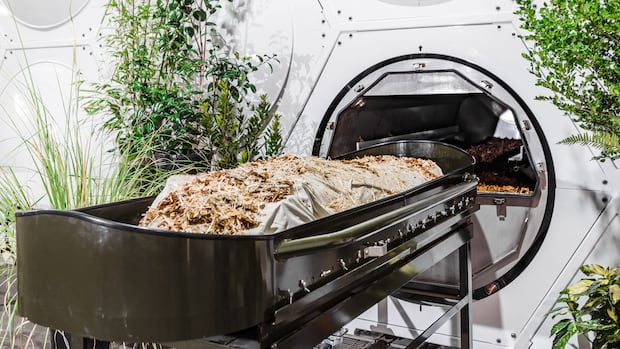Welcome to our weekly newsletter where we highlight environmental trends and solutions that are moving us to a more sustainable world.
Hi, it’s Anand. I’m talking about death again because a reader mentioned medical implants as one potential barrier to a truly green burial. So, I looked into two alternatives.
This week:
Liquified, composted: How green are these alternative death practices?
The Big Picture: Floating solar stands up tall
Waste pickers want deposits back on more materials — and it’s not just about the money
Liquified, composted: How green are these alternative death practices?
Sam Sieber stands in her company’s plant in front of an Aquamation system, designed for pets. (Bio-Response Solutions)
For more than 20 years, Sam Sieber’s family has been in the business of Aquamation, their trademark for using mostly water to rapidly break down a body without emitting carbon into the air.
“We thought this was a huge environmental pull and the number one reason families would choose it,” explained Sieber, Chief Strategy Officer for Bio-Response Solutions.
“We were wrong, it’s not.”
Turns out, as Sieber talked to more families, choosing Aquamation was more about finding an alternative to flame cremation.
“We hear stories, ‘Dad always loved water, every summer on the lake.’ So sometimes there's a draw to the water,” Sieber told CBC News from Danville, Ind. “And then we're also finding probably the biggest reason is people just perceive it to be more gentle.”
A new Aquamation system for a single human body, from Bio-Response Solutions in Danville, Ind. (Bio-Response Solutions)
Gentle isn’t the first word that comes to mind when looking at the industrial steel drum that’s used in the process, formally known as alkaline hydrolysis. Inside, water — along with heat, pressure and chemicals to make that solution alkaline — circulates around the body, speeding up its breakdown and leaving only the bones behind, in a matter of hours.
The results, say its proponents, are less energy use (temperatures are 90 to 150 C compared to flame cremation’s 750 to 1000 C), more solid remains (the process boasts 20 to 30 per cent more ashes than flame cremation’s estimated ~2 kgs) and no airborne emissions — the liquid remains are sent to wastewater treatment.
Sieber adds that surgical devices and implants like
Continue Reading on CBC News
This preview shows approximately 15% of the article. Read the full story on the publisher's website to support quality journalism.
